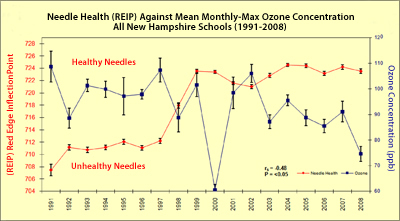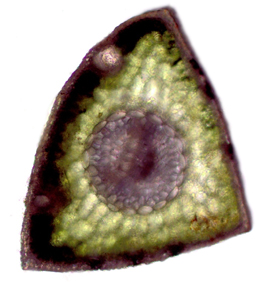The Science
The Forest Watch program studies the effects of ground-level ozone on the health of New England’s forests. K-12 students, teachers and researchers at the University of New Hampshire have been working together each year since 1991 collecting large amounts of data from white pine (Pinus strobus) trees all across New England.
 |
|
| Forest Watch chart of ground-level ozone concentrations shows that when needles were unhealthy in the 1990s, ozone levels were high. When ozone levels began to drop, white pine health soared. |
Forest Watch has confirmed the connection between ozone levels and white pine health. Over the past two decades, in all but a few drought years, white pine health has declined when ozone levels were high. White pine health has improved when ozone levels dropped.
 |
|
| A cross section of a single white pine needle shows the vascular bundle of xylem and phloem in the center. Green mesophyll cells filled with chlorophyll surround it. |
These biometric measures of plant health correlate with spectral measures of light reflected from needle surfaces. Students, teachers and UNH scientists have collaborated to build a 20-year data base of white pine measures, tracking the impact of low level ozone on the New England forest. Forest Watch Data Books provide a remarkable history of our measurements and findings.
More information:
White Pine Materials for Schools...
Outreach/Inreach...
